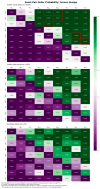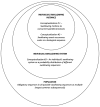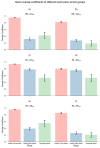Using Sequence Analyses to Quantitatively Measure Oropharyngeal Swallowing Temporality in Point-of-Care Ultrasound Examinations: A Pilot Study
- PMID: 38673561
- PMCID: PMC11051012
- DOI: 10.3390/jcm13082288
Using Sequence Analyses to Quantitatively Measure Oropharyngeal Swallowing Temporality in Point-of-Care Ultrasound Examinations: A Pilot Study
Abstract
(1) Background: Swallowing is a complex process that comprises well-timed control of oropharyngeal and laryngeal structures to achieve airway protection and swallowing efficiency. To understand its temporality, previous research adopted adherence measures and revealed obligatory pairs in healthy swallows and the effect of aging and bolus type on the variability of event timing and order. This study aimed to (i) propose a systemic conceptualization of swallowing physiology, (ii) apply sequence analyses, a set of information-theoretic and bioinformatic methods, to quantify and characterize swallowing temporality, and (iii) investigate the effect of aging and dysphagia on the quantified variables using sequence analyses measures. (2) Method: Forty-three participants (17 young adults, 15 older adults, and 11 dysphagic adults) underwent B-mode ultrasound swallowing examinations at the mid-sagittal plane of the submental region. The onset, maximum, and offset states of hyoid bone displacement, geniohyoid muscle contraction, and tongue base retraction were identified and sorted to form sequences which were analyzed using an inventory of sequence analytic techniques; namely, overlap coefficients, Shannon entropy, and longest common subsequence algorithms. (3) Results: The concurrency of movement sequence was found to be significantly impacted by aging and dysphagia. Swallowing sequence variability was also found to be reduced with age and the presence of dysphagia (H(2) = 52.253, p < 0.001, η2 = 0.260). Four obligatory sequences were identified, and high adherence was also indicated in two previously reported pairs. These results provided preliminary support for the validity of sequence analyses for quantifying swallowing sequence temporality. (4) Conclusions: A systemic conceptualization of human deglutition permits a multi-level quantitative analysis of swallowing physiology. Sequence analyses are a set of promising quantitative measurement techniques for point-of-care ultrasound (POCUS) swallowing examinations and outcome measures for swallowing rehabilitation and evaluation of associated physiological conditions, such as sarcopenia. Findings in the current study revealed physiological differences among healthy young, healthy older, and dysphagic adults. They also helped lay the groundwork for future AI-assisted dysphagia assessment and outcome measures using POCUSs. Arguably, the proposed conceptualization and analyses are also modality-independent measures that can potentially be generalized for other instrumental swallowing assessment modalities.
Keywords: aging; deglutition; dysphagia; information theory; ultrasonography.
Conflict of interest statement
The authors declare no conflicts of interest.
Figures








Similar articles
-
Temporal measures of oropharyngeal swallowing events identified using ultrasound imaging in healthy young adults.PLoS One. 2022 Jun 28;17(6):e0270704. doi: 10.1371/journal.pone.0270704. eCollection 2022. PLoS One. 2022. PMID: 35763508 Free PMC article.
-
Automated assessment of hyoid movement during normal swallow using ultrasound.Int J Lang Commun Disord. 2022 May;57(3):615-629. doi: 10.1111/1460-6984.12712. Epub 2022 Mar 14. Int J Lang Commun Disord. 2022. PMID: 35285113 Free PMC article.
-
Ultrasonographic evaluation of geniohyoid muscle and hyoid bone during swallowing in young adults.Laryngoscope. 2015 Aug;125(8):1886-91. doi: 10.1002/lary.25224. Epub 2015 Mar 5. Laryngoscope. 2015. PMID: 25739655
-
Effect of Bolus Viscosity on the Safety and Efficacy of Swallowing and the Kinematics of the Swallow Response in Patients with Oropharyngeal Dysphagia: White Paper by the European Society for Swallowing Disorders (ESSD).Dysphagia. 2016 Apr;31(2):232-49. doi: 10.1007/s00455-016-9696-8. Epub 2016 Mar 25. Dysphagia. 2016. PMID: 27016216 Free PMC article. Review.
-
Presentation of oropharyngeal dysphagia and rehabilitative intervention following esophagectomy: a systematic review.Dis Esophagus. 2018 Aug 1;31(8):doy050. doi: 10.1093/dote/doy050. Dis Esophagus. 2018. PMID: 29788321 Free PMC article.
Cited by
-
Validity and Reliability of Ultrasound Assessment of Swallowing Function: A Systematic Review and Meta-Analysis.J Oral Rehabil. 2025 Jul;52(7):1094-1110. doi: 10.1111/joor.13992. Epub 2025 May 2. J Oral Rehabil. 2025. PMID: 40317751 Free PMC article.
References
-
- Pongpipatpaiboon K., Inamoto Y., Matsuo K., Aoyagi Y., Shibata S., Kagaya H. Dysphagia Evaluation and Treatment: From the Perspective of Rehabilitation Medicine. Springer; Singapore: 2018. Physiological models of swallowing; pp. 17–25.
-
- Chiaramonte R., Di Luciano C., Chiaramonte I., Serra A., Bonfiglio M. Multi-disciplinary clinical protocol for the diagnosis of bulbar amyotrophic lateral sclerosis. Acta Otorrinolaringol. (Engl. Ed.) 2019;70:25–31. - PubMed
Grants and funding
LinkOut - more resources
Full Text Sources

